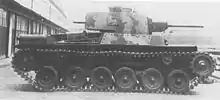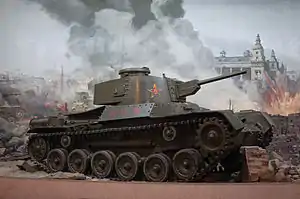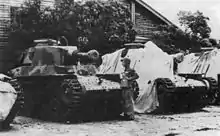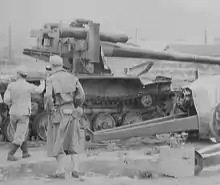Type 97 ShinHoTo Chi-Ha medium tank
The Type 97 Shinhoto Chi-Ha was a Japanese medium tank used in World War II that was an upgrade to the original Type 97 Chi-Ha. The new version was designated Type 97-Kai ("improved") or Shinhoto Chi-Ha ("new turret" Chi-Ha). This design was considered to be the best Japanese tank to have seen combat service during the Pacific War.
| Type 97 Shinhoto Chi-Ha | |
|---|---|
 Type 97 Shinhoto Chi-Ha on display at the United States Army Ordnance Museum in Aberdeen | |
| Type | Medium tank |
| Place of origin | Empire of Japan |
| Production history | |
| Designed | 1939-1941 |
| No. built | 930[1] |
| Specifications (Type 97-Kai as of 1942[2]) | |
| Mass | 16 tonnes (18 tons) |
| Length | 5.50 m (18 ft 1 in) |
| Width | 2.33 m (7 ft 8 in) |
| Height | 2.38 m (7 ft 10 in) |
| Crew | 5 (Commander, gunner, loader, bow gunner, driver) |
| Armor | Turret front: 33 mm[3] Turret sides: 26 mm[3] Hull front: 25 mm[3] Hull sides: 26 mm[3] Hull rear: 20 mm[3] |
Main armament | 1 x Type 1 47 mm tank gun[4] |
Secondary armament | 2 x 7.7 mm Type 97 machine guns |
| Engine | Mitsubishi SA12200VD air-cooled V-12 diesel (21.7 litres) 170 hp (125 kW) at 2,000 rpm |
| Suspension | Bell crank |
Operational range | 210 km (130 mi) |
| Maximum speed | 38 km/h (24 mph) |
Development
Japanese Army observers had watched tank developments in Europe and studied as avidly as any European military the operational experiences gained by German, Soviet, and Italian tanks in the Spanish Civil War (1936-1939). In order to improve the anti-tank capability of the Type 97 Chi-Ha medium tank, a new enlarged three-man turret armed with a high-velocity 47 mm gun was combined with the Chi-Ha's hull; hence the new name Kai ("improved") or Shinhoto ("new turret").[4] In 1942, it replaced the original model Type 97 in production. In addition "about 300" of the Type 97 tanks with the older model turret and 57 mm main gun were converted.[5]
Combat history

When the Type 97 entered service, properly equipped and supported, mechanized infantry units were realized. Type 97 Shinhoto tanks were first used in combat during the Battle of Corregidor in the Philippines in 1942.[6] A special company known as the "Matsuoka Detachment" was formed from the 2nd Tank Regiment and sent to the Philippines. According to an after-action report, they performed well in combat by "silencing several American defensive positions".[7]
The Japanese commanders showed a "skillful and imaginative use of tanks" during the early string of victories of the Japanese military forces.[1] The skill with which they maneuvered their mechanized infantry divisions was best seen in the Japanese invasion of Malaya, where the lighter weight of Japanese medium tanks allowed for a rapid ground advance so heavily supported by armor that British defenders never had a chance to establish effective defense lines.
During the Battle of Guam, 29 Type 97 and Type 95 tanks of the IJA 9th Tank Regiment and nine Type 95s of the 24th Tank Company were lost to bazooka fire or M4 tanks.[8] At the Battle of Okinawa, 13 Type 95s and 14 Type 97 Shinhoto medium tanks of the understrength IJA 27th Tank Regiment faced 800 American tanks of eight US Army and two USMC tank battalions.[9] The Japanese tanks were defeated in their counter-attacks of 4–5 May 1945. Similar conditions were repeated in the Kwantung Army's defense against the Soviet invasion of Manchuria, although there was little tank-versus-tank action. The Soviet Red Army captured 389 tanks.[10]

While vulnerable to opposing Allied tanks (such as the M3 Lee/Grant, M4 Sherman and Soviet T-34), the 47 mm high-velocity gun did give the Type 97 ShinHoTo a fighting chance against them. The 47 mm gun was effective against light tanks and against the sides and rear of the Sherman tank.[11] For this reason, some ShinHoTo Chi-Ha tanks were dug in concealed positions to ambush the American tanks and others were dug in to form the core of defense "strong points" during the battles for Luzon and Iwo Jima in 1945.[12] The Type 97 ShinHoTo Chi-Ha served against allied forces throughout the Pacific and East Asia as well as the Soviets during the July–August 1945 conflict in Manchuria.[13] It is considered to be the best Japanese tank to have seen "combat service" in the Pacific War.[14]
Some Japanese tanks remained in use, postwar during the Chinese Civil War. After the end of World War II, IJA tanks captured by the Soviets were turned over to the Communists Chinese army. After victory, the Chinese People's Liberation Army (PLA) continued to use them in their inventory.[15][16] The PLA's force of 349 tanks in 1949 included many Type 97 ShinHoTo Chi-Ha tanks.[15]


Short Barrel 120 mm Gun Tank
The Short Barrel 120 mm Gun Tank was a variant of the Type 97 Shinhoto Chi-Ha produced late in the war for the Imperial Japanese Navy. They wanted a gun tank similar to the Type 2 Ho-I for close support, but with greater fire-power. The standard 47 mm main tank gun was replaced with a short barrel naval 12 cm (120 mm) "anti-submarine" gun with a muzzle brake added.[17] In addition, it had a small storage compartment added onto the back of the Shinhoto Chi-Ha turret. Only "about a dozen" were produced for deployment by the Japanese Special Naval Landing Forces.[17][18]
IJN Long barrel 120 mm SPG
There was a "one-off" prototype developed by the Imperial Japanese Navy known as the Naval 12 cm SPG (self-propelled gun) or Long Barrel 120 mm SPG. A Type 10 120 mm main gun was mounted backwards on a Type 97 Chi-Ha chassis.[19] The gun was not housed in a turret like the Short Barrel 120 mm version and did not have a casemate. The post-war fate of the completed prototype deployed at the Yokosuka SNLF base is unknown.[19]
Notes
- Zaloga 2007, p. 17.
- Tomczyk 2007, pp. 19, 21.
- Zaloga 2012, p. 23.
- Zaloga 2007, pp. 13, 14.
- Zaloga 2007, p. 14.
- Zaloga 2007, p. 16.
- Zaloga 2012, pp. 12, 13.
- Zaloga 2007, p. 35.
- Zaloga 2007, pp. 34–40.
- Zaloga 2007, pp. 11, 41.
- Tomczyk 2005, p. 61.
- Tomczyk 2005, pp. 61, 62, 71, 76, 82.
- Tomczyk 2007, p. 19.
- Zaloga 2012, p. 15.
- Zaloga 2007, p. 42.
- Tomczyk 2007, pp. 19, 22.
- Zaloga 2007, p. 21.
- Tomczyk 2005, pp. 36, 37.
- Taki's Imperial Japanese Army: Long Barrel 12cm SP Gun
References
- Tomczyk, Andrzej (2007) [2002]. Japanese Armor Vol. 2. AJ Press. ISBN 978-8372371119.
- Tomczyk, Andrzej (2005). Japanese Armor Vol. 4. AJ Press. ISBN 978-8372371676.
- Zaloga, Steven J. (2007). Japanese Tanks 1939–45. Osprey. ISBN 978-1-8460-3091-8.
- Zaloga, Steven J. (2012). M4 Sherman vs Type 97 Chi-Ha: The Pacific 1945. Osprey. ISBN 978-1849086387.